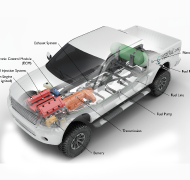Natural Gas Vehicles
Natural gas powers more than 175,000 vehicles in the United States and roughly 23 million vehicles worldwide. Natural gas vehicles (NGVs) are good choices for high-mileage, centrally fueled fleets because they can provide similar fuel range support for applications that stay within a region supported by reliable compressed natural gas (CNG) fueling. For vehicles that travel long distances, liquefied natural gas (LNG) offers a greater energy density than CNG, meaning the fuel range is more comparable to conventional fuel. The advantages of natural gas as a transportation fuel include its domestic availability, widespread distribution infrastructure, and reduced greenhouse gas emissions over conventional gasoline and diesel fuels.
The horsepower, acceleration, and cruise speed of NGVs are comparable with those of equivalent, conventionally fueled vehicles. Also, compared with conventional diesel and gasoline vehicles, NGVs offer other air quality benefits beyond greenhouse gas emissions.
Medium- and heavy-duty NGVs are available from original equipment manufacturers, as well as through qualified system retrofitters. Qualified system retrofitters can also economically, safely, and reliably convert many vehicles for natural gas operation with aftermarket conversion systems. CNG and LNG are considered alternative fuels under the Energy Policy Act of 1992.
Types of Natural Gas Vehicles
There are three types of NGVs:
- Dedicated: These vehicles are designed to run only on natural gas.
- Bi-fuel: These vehicles have two separate fueling systems that enable them to run on either natural gas or gasoline.
- Dual-fuel: These vehicles have fuel systems that run on natural gas but use diesel fuel for ignition assistance. This configuration is traditionally limited to heavy-duty vehicles.
CNG vehicles store natural gas in tanks where it remains in a gaseous state under pressure. More fuel can be stored onboard a vehicle using LNG because the fuel is stored as a liquid, making its energy density greater than that of CNG. This makes LNG well suited for Class 7 and 8 trucks requiring a greater range. Often, the fuel choice is determined by factors such as vehicle application needs (e.g., power requirements) and the required driving range.
The driving range of NGVs is generally less than that of comparable diesel or gasoline vehicles due to the lower energy density of natural gas. Extra storage tanks can increase range, but the additional weight may displace cargo capacity.
